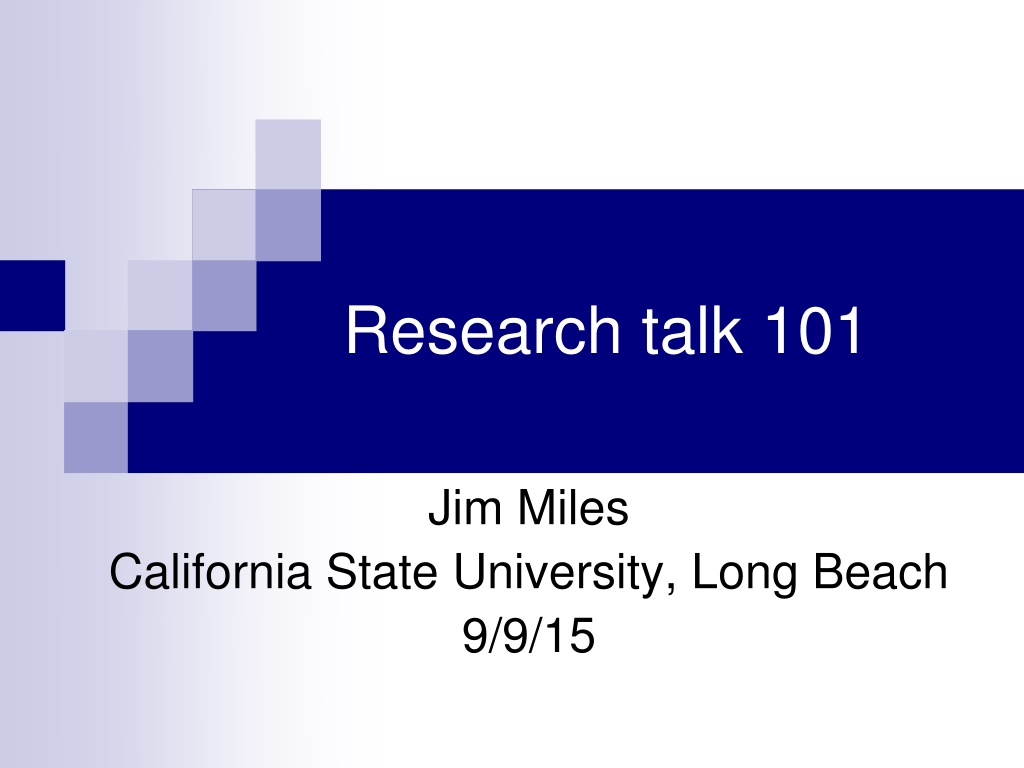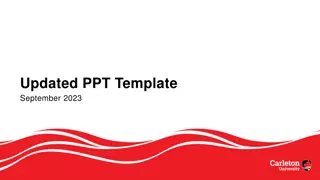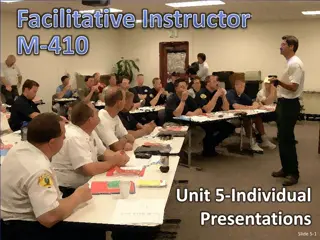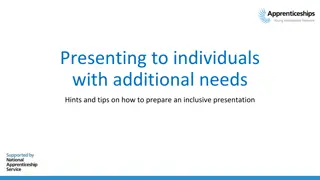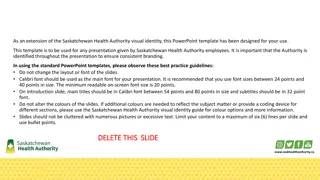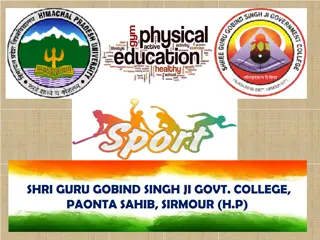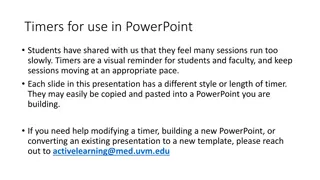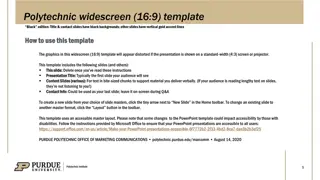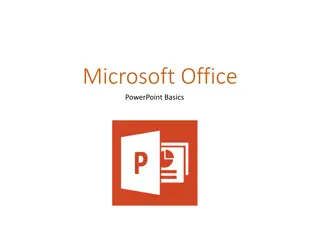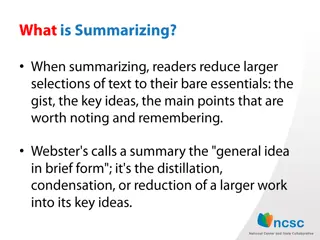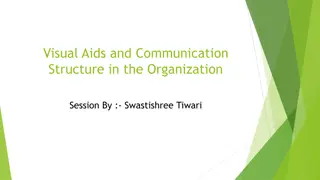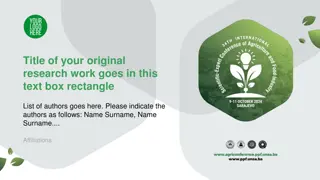Best Practices for Engaging Research Presentations
Research talks should focus on engaging the audience by providing a clear idea of the work, motivating interest, and being mindful of the audience's attention span. Key tips include understanding the audience, presenting technical details selectively, and preparing concise, visually appealing slides with minimal text. Effective presentation techniques such as early motivation, clear structure, and use of relevant visuals can enhance the impact of research talks.
Download Presentation

Please find below an Image/Link to download the presentation.
The content on the website is provided AS IS for your information and personal use only. It may not be sold, licensed, or shared on other websites without obtaining consent from the author.If you encounter any issues during the download, it is possible that the publisher has removed the file from their server.
You are allowed to download the files provided on this website for personal or commercial use, subject to the condition that they are used lawfully. All files are the property of their respective owners.
The content on the website is provided AS IS for your information and personal use only. It may not be sold, licensed, or shared on other websites without obtaining consent from the author.
E N D
Presentation Transcript
Research talk 101 Jim Miles California State University, Long Beach 9/9/15
Purpose of a research talk Is not to Show everyone how smart you are Tell them all you know about a subject Present every little detail of your work Is to Give the audience a sense of what your idea/work is Make them want to read your paper Get feedback on your work
Know your audience Keep in mind They might be tired They are thinking Why should I listen? Non-experts tune off within 2 min. Experts after 5 min. What can you do?
What can you do? Early motivation - motivate your research with easy to understand examples Spoil the punch line - State your results early and in simple terms Visuals Illustrate your idea with RELEVANT images and diagrams
Where were you? People will get lost during your talk, even those who are listening have a running outline of the main steps of your idea Reminding people lowers working memory load (RPLWML) I can mention RPLWML again right now, but will you remember it in 5 or 6 slides?
Technical details: in or out? A fine line Present specific aspect that show the meat of your work Leave the rest out. If you were convincing they will read your paper Don t fill up your slides with lots of equations and numbers Prepare back-up slides to answer questions. Leave them at the end of the presentation
Preparing the presentation Less is more. Fill in with narration not words Use animation sparingly Use color to emphasize some points but limit to 2 or 3 colors Be consistent in the choice and use of color font size/type etc. Use slide real estate appropriately
Slide layout - Bad This page contains too many words for a presentation slide. It is not written in point form, making it difficult both for your audience to read and for you to present each point. Although there are exactly the same number of points on this slide as the previous slide, which was five, it looks much more complicated. In short, your audience will spend too much time trying to read this paragraph instead of listening to you.
Slide layout Good Show one point at a time: Will help audience concentrate on what you are saying Will prevent audience from reading ahead Will help you keep your presentation focused
On the other hand A very annoying technique is to reveal your points one by one by one, unless there is a punch line
Where were you? What was RPLWML? Keeping RPLWML in mind takes up valuable attentional and memory resources.
Fonts - Good Use different size fonts for main points and secondary points this font is 24-point (minimum!), the main point font is 32-point, and the title font is 44- point Use a standard font like Times New Roman or Arial
Fonts - Bad If you use a small font, your audience won t be able to read what you have written Don t use a complicated font CAPITALIZE ONLY WHEN NECESSARY. IT IS DIFFICULT TO READ. IT ALSO MAKES YOU SEEM CRAZY OR ANGRY.
Color - Good Use font color that contrasts sharply with the background Blue font on white background Use color to reinforce the logic of your structure Ex: light blue title and dark blue text Use color to emphasize a point But only use this occasionally
Color - Bad Using a font color that does not contrast with the background color is hard to read Using color for decoration is distracting and annoying. Using a different color for each point is unnecessary Same for secondary points Trying to be creative can also be bad
Background - Good Use backgrounds such as this one that are attractive but simple Use black on white or white on black Use the same background consistently throughout your presentation
Background Bad Avoid backgrounds that are distracting or difficult to read from Always be consistent with the background that you use
Graphs - Good Use graphs rather than just charts and words Data in graphs is easier to comprehend & retain than is raw data Trends are easier to visualize in graph form Always title your graphs
Graphs - Bad January February March April Blue Balls Red Balls 20.4 30.6 27.4 38.6 90 20.4 31.6 34.6
Graphs - Good Items Sold in First Quarter of 2002 100 90 80 70 60 Blue Balls Red Balls 50 40 30 20 10 0 January February March April
Graphs - Bad 100 90 90 80 70 60 Blue Balls Red Balls 50 38.6 40 34.6 31.6 30.6 27.4 30 20.4 20.4 20 10 0 January February March April
Graphs - Bad Minor gridlines are unnecessary Font is too small Colors are illogical Title is missing Shading is distracting
Preparing the presentation Prepare the slides in advance Show them to friends When you think you are done read them again Check all animations with the sound on
Preparing the presentation Practice, practice, practice Give a practice talk to a general audience Give a practice talk to an audience of experts Time your presentation (allow for speed up effect caused by nervousness) Always assume technology will fail you. Have backups.
Delivering the talk Be enthusiastic! If you aren t why should the audience be? Make eye contact with the audience Identify a few nodders and speak to them Watch for questions. Be prepare to digress or brush off when irrelevant
Delivering the talk Point at the screen not the computer Do not read directly from the PPT or your notes Have the spill for the first couple of slides memorized in case you go blank Finish in time
Handling questions Different types handle accordingly Need clarification Suggest something helpful Want to engage in research dialog Show that he/she is better than you Anticipate questions (additional slides) Don t let them highjack the talk (postpone) (Almost) Never cut off a question
Some resources http://research.microsoft.com/~simonpj/pa pers/giving-a-talk/writing-a-paper- slides.pdf http://wit.tuwien.ac.at/research/tips/good_r esearch_talk_slides.pdf http://research.microsoft.com/~simonpj/pa pers/giving-a-talk/giving-a-talk-html.html
Some resources http://www.cse.buffalo.edu/~rapaport/howt owrite.html http://www.iasted.org/conferences/formatti ng/Presentations-Tips.ppt
